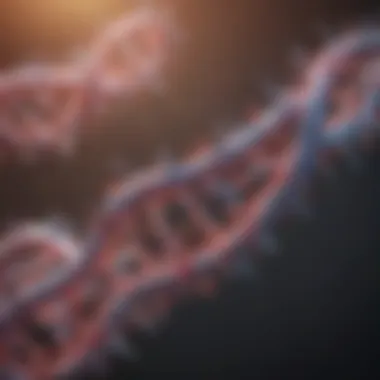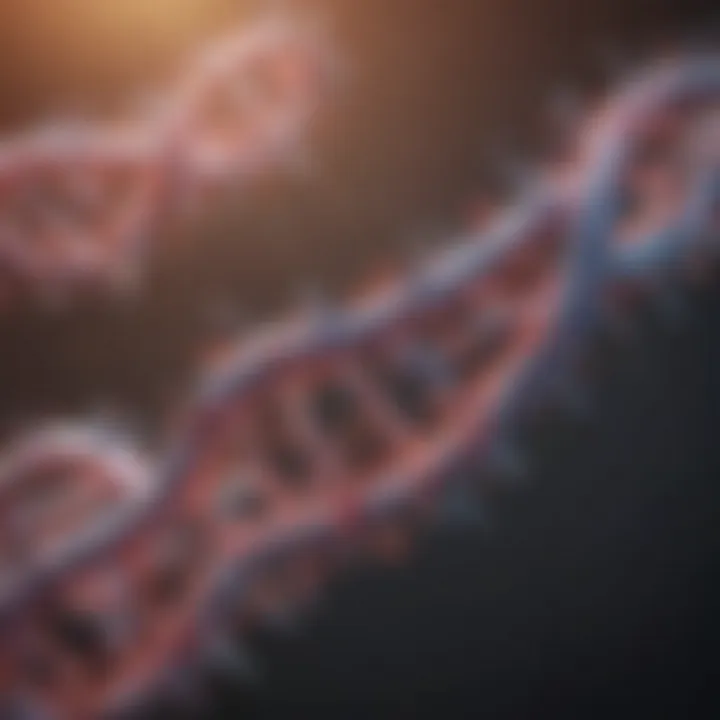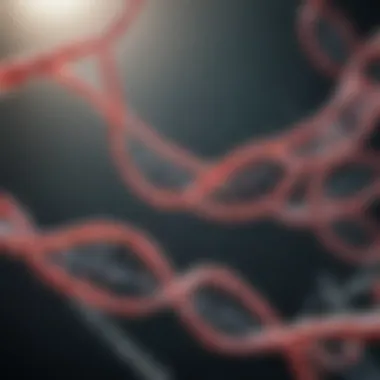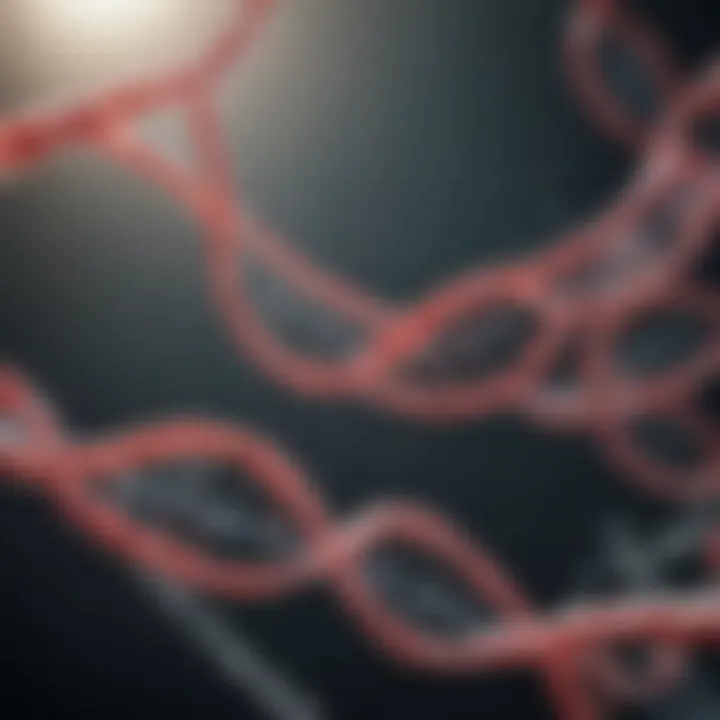Ribo Depletion: A Comprehensive Examination


Intro
Ribo depletion plays a pivotal role in the landscape of molecular biology. This technique focuses on reducing the ribosomal RNA (rRNA) content, thus allowing for a clearer assessment of mRNA in transcriptomic studies. By diminishing the background noise created by rRNA, researchers can enhance the sensitivity and accuracy of their analyses. This introduction aims to set the stage for an in-depth examination of ribo depletion, articulating its relevance within modern scientific inquiry and laying the groundwork for a comprehensive discussion on methodologies, implications, and advancements.
Research Overview
Methodological Approaches
The methodologies involved in ribo depletion have evolved over time. Traditional techniques include enzymatic digestion and affinity-based removal. More recent advances incorporate various kits and reagents, such as the Ribo-Zero from Illumina or the CleanTag from PCR Biosystems. The selection of a particular method should depend on the specific goals of the research and the type of RNA sample being analyzed.
- Enzymatic Digestion: This approach uses ribonucleases to selectively target and degrade rRNA.
- Affinity-Based Removal: This method utilizes oligonucleotides to bind and precipitate rRNA from the sample.
- Commercial Kits: Ready-made solutions have streamlined the ribo depletion process, providing a more standardized approach to RNA purification.
In implementing these methodologies, it is crucial to monitor the efficiency of ribo depletion. Ensuring sufficient reduction of rRNA while preserving mRNA integrity is vital for achieving credible results in downstream applications.
Significance and Implications
The significance of ribo depletion extends beyond its methodological aspects. It holds considerable implications for RNA sequencing technologies. By effectively removing rRNA, researchers can focus on the transcriptome, leading to more accurate reflections of gene expression. This is particularly important for studies exploring differential expression, alternative splicing, and non-coding RNAs.
Moreover, ribo depletion assists in minimizing sequencing costs by reducing the volume of data generated from non-target sequences. Therefore, it becomes a strategic choice that impacts both the efficiency and accuracy of genomic studies.
"Ribo depletion transforms the way we conduct transcriptomic studies, striping away the superfluous to unveil the essence of gene expression."
Current Trends in Science
Innovative Techniques and Tools
As scientific inquiry progresses, ribo depletion methods continue to advance. Emerging techniques now leverage next-generation sequencing technologies, incorporating multiplexing strategies to analyze multiple samples simultaneously.
- Single-cell RNA-Sequencing: Advances in ribo depletion are crucial to enable single-cell analysis, allowing for the nuance of individual cellular identities to surface.
- Targeted RNA-Sequencing: This strategy tailors the sequencing process to focus only on specific gene sets, optimizing resource use.
Interdisciplinary Connections
The relevance of ribo depletion organically intersects with various fields such as genetics, bioinformatics, and systems biology. As interdisciplinary approaches illuminate new connections, the potential of ribo depletion to influence diverse research domains becomes increasingly clear. By fostering collaborative efforts, scientists can better understand complex biological systems and enhance the effectiveness of ribo depletion methodologies.
The exploration of these dimensions will provide a more nuanced understanding of ribo depletion's potential, positioning it as a foundational tool in the ever-evolving field of molecular research.
Intro to Ribo Depletion
Ribo depletion is an essential technique in modern molecular biology. Its primary aim is to reduce the levels of ribosomal RNA in various biological samples. By doing so, researchers can enhance the focus on messenger RNA, which is more relevant for studying gene expression. This method is important as it improves the sensitivity and accuracy of transcriptomic analyses, providing clearer insights into gene activity and cellular function.
Definition and Importance
Ribo depletion can be defined as the process of selectively removing ribosomal RNA (rRNA) from total RNA samples. Ribosomal RNA constitutes a large proportion of total RNA, often exceeding 90% in some cells. Consequently, the excessive amount of rRNA can interfere with the detection of low-abundance transcripts, making it challenging to obtain a comprehensive overview of the transcriptome.
By depleting rRNA, the analytical focus shifts towards messenger RNA, thereby improving the overall data quality. This is particularly significant for studies involving low-expressed genes, which could otherwise be overshadowed by the background noise created by rRNA. Given the reliance on RNA sequencing for various applications—from basic research to clinical settings—ribo depletion is a cornerstone technique that maximizes the utility of RNA analyses.
Historical Background
The evolution of ribo depletion techniques can be traced back to the early 2000s when high-throughput sequencing began to gain traction. Before this, traditional methods of RNA extraction did not adequately address the rRNA dominance issue. Initial efforts to separate rRNA from mRNA were rudimentary and often yielded inconsistent results.


As demand for more precise RNA profiling increased, innovative methods emerged. The first significant advancements involved various hybridization techniques that utilized oligonucleotide probes specifically designed to capture and remove rRNA. In the years that followed, researchers began to refine these methods, leading to the development of enzymatic approaches, such as using RNases to selectively degrade rRNA.
The enhancement of ribo depletion methodologies has aligned closely with the growth of RNA sequencing technologies. Current techniques prioritize efficiency and speed, with an eye towards reducing sample loss. Over time, the field has seen substantial improvements, resulting in robust protocols that facilitate research across various domains, including genetics, oncology, and developmental biology.
By understanding its history and significance, researchers can better appreciate the role of ribo depletion in contemporary studies, ultimately driving innovation and excellence in molecular biology.
Understanding Ribosomal RNA
Ribosomal RNA, often abbreviated as rRNA, is a fundamental component of the cellular machinery. This segment of RNA plays a crucial role in the synthesis of proteins, which are essential for various cellular processes. Understanding ribosomal RNA is essential for comprehending the mechanisms of transcription and translation, as well as the broader implications these processes have on molecular biology and genetics.
Structure and Function
Ribosomal RNA is primarily found within the ribosome, the molecular complex responsible for protein synthesis. This structure is made up of both rRNA and ribosomal proteins that come together to form two subunits: the large and the small subunit. The unique architecture of rRNA contributes to the ribosome's overall functionality.
The function of ribosomal RNA can be categorized into several key areas:
- Catalytic activity: rRNA is not just a passive participant; it exhibits ribozyme activities, meaning it can catalyze specific biochemical reactions. This DNA/RNA enzymatic capability underlines the depth of its role in protein translation.
- Structural scaffolding: The rRNA itself serves as a scaffold that ensures the proper alignment of messenger RNA and transfer RNA during protein synthesis. Its specific folding and structural domains are critical for maintaining the ribosome's integrity.
- Regulatory functions: rRNA can influence the dynamics of ribosome assembly and disassembly, which is pivotal for cellular response to environmental stimuli.
Through its multifaceted functions, ribosomal RNA significantly impacts cellular growth and metabolism, making its study vital in areas like genetics and bioinformatics.
Role in Cellular Biology
Ribosomal RNA holds vital significance in the landscape of cellular biology. It not only drives protein synthesis but also mediates the overall metabolic activities that sustain life. The roles it plays include:
- Protein synthesis: The primary function remains the translation of genetic information into functional proteins, which are the building blocks of cells. This process is essential for cellular functions ranging from repair to replication.
- Cell growth and division: Ribosomal RNA is intricately involved in cell proliferation. A higher level of rRNA often corresponds to increased ribosomal production, which directly influences the rate at which a cell can produce proteins necessary for division.
- Response to environmental changes: Cells can modify rRNA expression in response to environmental cues, such as nutrient availability or stress, allowing for calibrated adjustments in protein synthesis. This adaptability is crucial for survival.
In summary, understanding ribosomal RNA is foundational for delving into more complex systems in molecular biology and biochemistry. Its structure, function, and roles in cellular activities point to its importance in both fundamental and applied sciences.
"The intricate design and functions of ribosomal RNA epitomize the elegance of genetic regulation and protein synthesis."
Exploring the nuances of rRNA gives insights into the cellular operations that underpin all biological systems.
Ribo Depletion Techniques
Ribo depletion techniques are essential methodologies in the field of molecular biology, focused primarily on reducing the percentage of ribosomal RNA (rRNA) in RNA samples. This is important because rRNA constitutes a large portion of total RNA in a cell, often overshadowing mRNA and other RNA types that researchers wish to study. By employing these techniques, scientists can enhance their analyses of gene expression, improve sequencing data quality, and ultimately gain a more precise understanding of the transcriptome. The selection of an appropriate ribo depletion method significantly influences the research outcomes, thus an in-depth understanding of the available techniques becomes essential.
Methods Overview
Ribo depletion techniques enlist various methods that can be categorized into two main classes: enzymatic approaches and hybridization techniques. Each of these methodologies aims to selectively remove rRNA while preserving mRNA and other non-ribosomal RNA components. The choice of method largely depends on factors such as sample type, desired sensitivity, and specific research objectives. Reviewing the broad landscape of these techniques reveals several key strategies:
- Enzymatic Digestion: Utilizes enzymes to target and degrade rRNA.
- Hybridization Capture: Relies on sequences complementary to rRNA for removal.
- Magnetic Bead Separation: Employs coated beads to isolate desired RNA types.
Understanding these methods lays the groundwork for selecting and optimizing the best technique for specific experimental conditions and goals.
Enzymatic Approaches
Enzymatic approaches represent a profound category of ribo depletion methods wherein enzymes are employed to specifically degrade ribosomal RNA. Common enzymes include RNase H, which can hydrolyze rRNA while leaving mRNA intact. This approach has certain advantages, such as efficiency and the ability to process larger sample volumes without the risk of introduceing too much bias into the resulting mRNA profile.
When enzymes like RNase H are used in conjunction with oligonucleotide primers that hybridize to rRNA, the resulting degradation leads to a more favorable mRNA-to-rRNA ratio. Though effective, these methods do require careful calibration of enzyme concentration and reaction time to avoid over-digestion of crucial RNA materials.


Hybridization Techniques
Hybridization techniques offer an alternative and widely used method for ribo depletion. In these protocols, oligonucleotide probes are designed to specifically bind to rRNA sequences in a sample. Once bound, the rRNA can be efficiently separated from the remaining RNA types using standards like precipitation or affinity capture.
This method is particularly beneficial for enriching mRNA without compromising its integrity. The specificity of probe design enhances selectivity, helping to mitigate potential contamination from other RNA types. Nonetheless, one of the recurring challenges with hybridization methods is ensuring the specificity of the probes and avoiding non-specific bindings, which can introduce noise in the data.
Comparative Analysis of Methods
Conducting a comparative analysis of ribo depletion methods yields valuable insights into the strengths and limitations of each approach. Factors such as sample size, RNA species prior to processing, and experiment type can influence the outcome of each technique. For instance, enzymatic approaches might favor workflows requiring high sensitivity, while hybridization techniques may be preferred for their simplicity and user-friendliness.
- Efficiency: Enzymatic methods often outperform hybridization in terms of depleting rRNA content quickly.
- Selectivity: Hybridization techniques tend to have better specificity, reducing the risk of removing essential mRNA inadvertently.
- Ease of Use: Some hybridization kits offer a more straightforward and less labor-intensive workflow.
In summary, a well-elaborated understanding of the diverse methods available for ribo depletion can enhance research quality and is crucial for the evolution of molecular techniques.
Applications of Ribo Depletion
Ribo depletion plays a crucial role in molecular biology, particularly in the analysis of RNA populations within a sample. This technique not only enhances the quality of transcriptomic analyses but also contributes substantially to advancements in various research fields. Understanding its applications provides insight into how this method can overcome several limitations that arise due to high ribosomal RNA (rRNA) content. The following subsections delve into specific areas where ribo depletion is prominently utilized, demonstrating its significance in modern scientific research.
Transcriptomic Studies
In transcriptomic studies, the primary goal is to analyze the total RNA population to understand gene expression patterns. Ribosomal RNA constitutes the vast majority of RNA extracted from cells, often exceeding 90 percent. This overabundance can obscure the detection of low-abundance mRNAs, skewing the interpretation of gene expression levels. By applying ribo depletion, researchers can significantly reduce the rRNA content in their samples, allowing for a more balanced view of the transcriptome. This enhanced sensitivity enables the detection of subtle changes in gene expression that could otherwise go unnoticed.
Moreover, effective ribo depletion methods improve the overall quality of RNA sequencing results. High-quality data is essential for accurate bioinformatics analysis, as it aids in the identification of differentially expressed genes and facilitates the discovery of novel transcripts. Thus, ribo depletion is instrumental in providing a clearer picture of cellular functioning under varying conditions, ultimately leading to more reliable conclusions in transcriptomic research.
Single-Cell RNA Sequencing
Single-cell RNA sequencing (scRNA-seq) is an innovative approach that allows for the analysis of gene expression at the individual cell level. This level of analysis is transformative because it reveals heterogeneity within cell populations that bulk RNA-sequencing fails to capture. However, standard protocols often struggle with high rRNA content, which muddles the results and makes interpretation difficult.
Ribo depletion becomes particularly beneficial in the context of scRNA-seq, where the small amount of starting material demands high sensitivity. By removing rRNA, researchers can obtain purer RNA profiles from single cells. This translates into clearer profiles for each cell, enhancing the accuracy of cell-type identification and the understanding of cellular responses. Thus, the application of ribo depletion in single-cell analyses can lead to discoveries in cellular interactions and developmental processes that were previously uncharacterized.
Clinical Research Implications
In the realm of clinical research, ribo depletion has significant implications for disease diagnosis and treatment. The ability to analyze non-coding RNAs, along with low-abundance transcripts, opens new avenues for understanding the molecular underpinnings of various diseases, including cancer and autoimmune disorders.
For instance, studies employing ribo depletion have successfully identified biomarkers that can serve as early indicators of disease. By focusing on a broader range of RNA molecules, researchers can uncover novel therapeutic targets, leading to more personalized treatment strategies. Furthermore, ribo depletion enhances the analysis of tumor microenvironments by allowing for a thorough examination of the RNA expression profiles of diverse cell types within tumors.
"Ribo depletion not only refines RNA analyses but also contributes to breakthroughs in understanding complex diseases."
Challenges and Limitations
Understanding the challenges and limitations of ribo depletion techniques is crucial for researchers and professionals working in molecular biology. These factors can significantly influence the outcomes of experiments and the interpretation of data. By recognizing potential pitfalls, one can better navigate the complexities of ribo depletion and enhance the robustness of research findings.
Technical Challenges
Ribo depletion poses several technical challenges that researchers must address. One primary concern is the efficiency of rRNA removal. Incomplete depletion can lead to residual ribosomal RNA contamination, affecting the overall quality of RNA samples. This factor can skew transcriptomic analyses, leading to unreliable data. Techniques used for depletion, such as enzymatic methods or hybridization approaches, vary in effectiveness. Thus, selecting the optimal method for a particular application is essential.
Another significant technical challenge is maintaining the integrity of the remaining RNA. The process of removing ribosomal RNA can inadvertently degrade the messenger RNA (mRNA) that researchers wish to analyze. Techniques used must be chosen carefully to minimize the risk of mRNA fragmentation.


Cost is also a notable challenge. High-quality ribo depletion kits, such as those offered by Illumina, can be expensive. For smaller laboratories or research setups, budget constraints may limit the scalability of experiments. Researchers must evaluate the trade-offs between cost and the accuracy of results, which can introduce further complications in study design.
Data Interpretation Issues
Interpreting data from ribo depletion experiments presents another layer of complexity. One of the main issues arises from the varriability in rRNA removal efficiency, which can hinder the comparability of results between different studies. Researchers must be cautious in drawing conclusions, as slight variations in ribo depletion can lead to significant differences in gene expression profiles.
There is also the challenge of annotation and alignment of sequences post-depletion. The reduction of rRNA can affect how reads align in RNA sequencing analysis. If sequences are not aligned properly, it can introduce biases in transcript quantification. This bias makes downstream analyses, such as differential expression, less reliable.
Finally, interpretation can be confounded by biological variability in the samples themselves. The presence of different cell types or states in heterogeneous samples can lead to discrepancies in the RNA profiles obtained after ribo depletion. Researchers must account for these biological factors in their analyses to ensure their findings are accurate and meaningful.
Ultimately, addressing technical challenges and media interpretation issues in ribo depletion is vital for conducting rigorous and replicable research in transcriptomics.
Future Directions in Ribo Depletion Research
Future directions in ribo depletion research are critical for advancements in molecular biology. As researchers strive for greater sensitivity and accuracy in transcriptomic analyses, understanding these future pathways becomes essential. The integration of novel techniques and technologies is pivotal to surpassing current limitations. These innovations promise to enhance our comprehension of biological processes by allowing more targeted examination of non-ribosomal RNA molecules.
Emerging Technologies
Emerging technologies in ribo depletion are at the forefront of enhancing the efficiency and efficacy of RNA studies. Among these, techniques such as CRISPR-based approaches are gaining attention. This method, traditionally associated with gene editing, shows promise in selectively depleting ribosomal RNA while preserving other RNA species.
Another significant avenue is the development of next-generation sequencing platforms. These platforms enable researchers to analyze complex RNA samples with improved throughput and resolution. Consequently, this advancement allows for a deeper exploration of transcriptomic diversity, revealing insights into cellular functions and disease mechanisms.
Additionally, advancements in microfluidics can lead to more effective ribo depletion by allowing precise control over sample processing. This increased control can minimize contamination and increase the reliability of the results, which is crucial for high-stakes research.
"Emerging technologies have the potential to redefine methodologies in RNA research, opening new avenues for understanding cellular dynamics."
Potential Innovations
Potential innovations in ribo depletion will continue to address some of the challenges currently faced in the field. One promising area is the development of more selective ribo depletion kits. Current methods can sometimes lead to unwanted depletion of non-ribosomal RNA, skewing the data. Innovations aimed at improving specificity could greatly enhance data quality and reliability.
Moreover, the incorporation of artificial intelligence in data analysis is likely to play a significant role in interpreting complex datasets generated from ribo depletion experiments. AI algorithms can uncover patterns and correlations that may be overlooked by traditional analysis methods. This would result in a more nuanced understanding of RNA dynamics in various biological contexts.
Furthermore, the field is anticipating innovations around real-time monitoring of ribo depletion processes. This could involve utilizing biosensors to track the effectiveness of depletion in real-time, offering immediate insights into experimental success and potentially saving time and resources during experiments.
Ultimately, these emerging technologies and innovations hold great promise for refining ribo depletion techniques. They will not only enhance research capabilities but also contribute to more robust scientific findings, further clarifying the complexities of RNA biology.
Closure
The conclusion serves as a critical section in this article, emphasizing the overall significance of ribo depletion within molecular biology. It encapsulates the key findings from previous sections, highlighting how these findings contribute to a deeper understanding of ribosomal RNA roles and challenges faced in research.
Summary of Findings
Ribo depletion is a pivotal technique, and its implications are profound. The analysis throughout this article illustrates how reducing ribosomal RNA enhances the quality of transcriptomic studies. By targeting this excess RNA, researchers can obtain clearer insights into gene expression dynamics. Notably, different methodologies offer unique advantages; enzymatic approaches generally favor faster processing times while hybridization techniques provide higher specificity in RNA removal. Each method presents trade-offs that need careful consideration during experimental design.
Moreover, the exploration of applications ranging from single-cell RNA sequencing to clinical research underscores its vast reach. The innovation landscape is growing, as emerging technologies promise to refine ribo depletion further, making it indispensable to molecular biology research. In summary, ribo depletion is not merely a technique but a necessity for accurate and efficient RNA analysis and interpretation.
Implications for Future Research
The implications of ribo depletion extend far beyond the laboratory. Future research directions can focus on optimizing existing methods or developing novel strategies that enhance efficiency and accuracy. As technologies evolve, researchers are encouraged to explore integration with other techniques like CRISPR or advanced bioinformatics tools.
Another important aspect is the exploration of ribo depletion in various biological contexts. How this technique can unravel complex cellular mechanisms in different organisms and conditions remains an open field of inquiry.
Ribo depletion is crucial for enhancing experimental accuracy and reliability.
In summary, the future holds great promise for enhancing our understanding of RNA biology through ribo depletion, presenting opportunities for groundbreaking discoveries in genomics, transcriptomics, and beyond.



